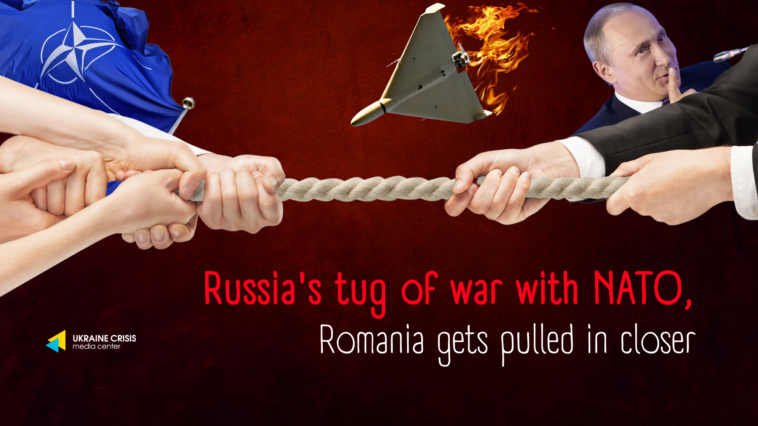Written by Anton Khimiak, Analyst at HWAG/UCMC
On the night of September 4, a Russian drone went down in Romania during an attack on Ukrainian port infrastructure. This incident became another media pretext for manipulations aimed at discrediting Ukraine.
Initially, Romania’s official position on this was to deny that a Russian UAV had crashed on its territory. Eventually, the wreckage of the drone was found on the Romanian bank of the Danube, and official Bucharest had to change its rhetoric. Thus, President Iohannis called the situation “a serious violation of Romania’s sovereignty and territorial integrity.”
Meanwhile, Russia, which has already carried out more than one similar provocation against NATO member states, has focused its propaganda efforts on accusing Kyiv of trying to drag Romania into the war.
Romania’s position
Initially, the Romanian Defense Ministry denied that the drone had gone down on its territory. The same thesis was repeated by Romanian President Klaus Iohannis: “No part, no drone, and no other part of any device has reached Romania.”
As of September 6, Romanian Defense Minister Angel Tilvar said that the wreckage of the Russian drone had been found on the territory of the country. The Romanian president, in turn, announced that an investigation into the incident had begun.
It is important to note that pro-Russian MPs are actively spreading pseudo-opposition narratives inside the country. This applies not only to this case, but also to the country’s course in general.
Romania’s official position can be characterized as inconsistent, but aimed at avoiding an escalation of the conflict with Russia. The inconsistency of statements and avoidance of sharp corners reveals fear of a potential conflict and the lack of a strategic vision of security communication. And this is not the first time this has happened.
In March 2022, a Russian Orlan-10 UAV landed in Romania. At the time, the authorities stated that it was not a threat, as the drone was a reconnaissance drone, not a strike drone.
Another incident occurred when a Russian missile violated Romanian airspace in February 2023. At the time, the Romanian Ministry of Defense denied the incident altogether, but confirmed that the missile was in Moldovan airspace.
Ukraine’s position
Ukrainian officials emphasize that since Russia is not just a “conditional threat” to the security of NATO countries, it directly threatens the near border of partner countries.
Ukraine insists that its defense forces need to be armed to avoid such situations in the future. Moreover, the Ukrainian government has repeatedly stated that its goal is to prevent the war from spreading to European countries.
A Russian manual
The Kremlin propagandists have worked the information pretext to the fullest and have intensified the narrative of “Romania’s (and, as a result, NATO’s) involvement in a direct conflict with Russia.” This sounds ridiculous, to say the least, in the context of Moscow’s numerous statements that they are already at war with NATO.
Russian officials have already spoken about “getting involved” in the context of other countries and situations. Russian President Vladimir Putin has said that the alliance is almost a party to the conflict. The Russian “media” have long and tediously peddled the thesis that Poland wants to get involved in the war.
Interestingly, at first the Kremlin actively supported the Romanian authorities’ denials about the downing of the drone. In this way, Moscow was completely fencing itself off from the situation and absolving itself of responsibility.
Next, Kremlin propagandists began to spread the fiction that it was Ukraine that chose Romania to draw NATO into the war. With this narrative, Russia systematically delegitimizes the Ukrainian government.
All of these messages have one goal: to sow discord among NATO countries by raising the level of escalation. Indirectly, this destabilizes the domestic political situation in Romania and calls into question its ability to defend its territory.
Raising the stakes in this confrontation could potentially lead to a real military response from NATO, and this would allow Russia to make a “goodwill gesture” not to “weak Ukraine” but to “big and strong NATO.” This would preserve the Kremlin’s political reputation in the eyes of its domestic audience and allow it to continue manipulating this scenario in the international arena. At the same time, it changes the perception of Ukraine as an aggressive state that needs NATO’s participation to win the war.
To summarize
Based on the systematic nature of Russia’s statements about the possibility of involving a particular NATO member state in a war with Russia, we can state that Moscow intends to continue escalating the conflict in order to weaken support for Ukraine.
Ukraine’s contribution to the preservation of peace in Europe critically depends on the supply of weapons from partner countries, primarily air defense systems. Without sufficient support and, especially, the supply of modern air defense systems, similar incidents will continue to occur, and Russia will manipulate again and again, creating threatening incidents.
Romania’s position is in line with the common policy of NATO countries, so we can talk about a certain vision of the alliance in the context of preventing direct escalation. It should be noted that NATO’s strategic policy on the Black Sea region is virtually non-existent, based on the national interests of the Black Sea members. This is extremely important for the actual security of NATO’s borders and the prevention of direct confrontation.
In order to effectively counter the threats posed by Russia in the Black Sea region, Romania needs to follow Poland’s example in the field of strategic security communications. Modernization of the army to create a real security space will play a significant role here. Also, the coherence of statements between the countries and the alliance will help avoid Kremlin manipulations. This will ultimately force Moscow to come up with more and more incredible narratives to continue its information influence. In turn, further detachment from reality will weaken its propaganda position.



